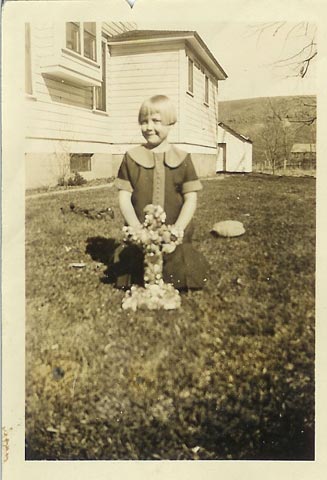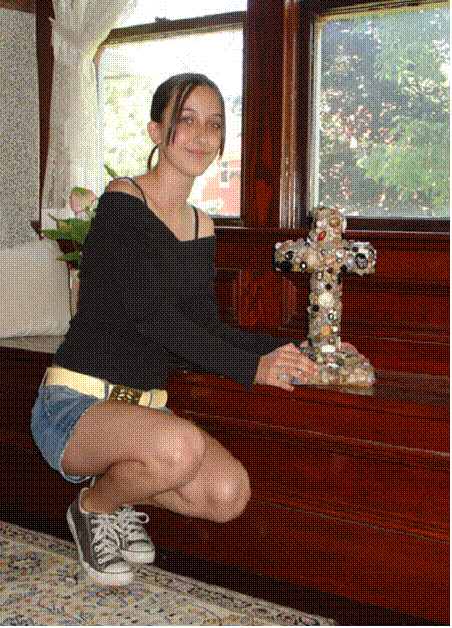

FROM THE DIRECTOR
Diane Biggs
THE CROSS STORY


Brenda Steunenberg ca. 1925 Caley Richards ca.2005
In the stairwell at Frazier Farmstead Museum sits an object of much
interest to museum visitors. It is about 16" high and is in the form of a cross.
It was crafted in the 1860ís by the maternal grandfather, James Theodore
Beardsley, of Earl and Lela Frazier and given to his daughters, Frances and Eva
Beardsley, when they were children. The cross is made of wood and covered with a
putty substance into which several hundred small trinket-like objects were
pressed while it was soft. The objects cover a wide range of objects from the
era of the Civil War; marbles, buttons, pieces of jewelry, small porcelain doll
parts, glass medicine bottles, and a variety of other Ďdoo-dadsí too numerous to
mention.
The cross came with Theodore and his wife Mary Jane Simpson Beardsley when they came west in the 1870ís. It remained in the family until Lela Frazierís death in 1983. Lela along with her brother Earl willed the Frazier home, contents and property to the Milton-Freewater Area Foundation and it was opened as a museum the following year. A web site was opened several years ago, with Gwen Martin managing the site. People from all across the country have contacted the museum with inquiries about their area-connected ancestors.
A couple of years ago, John Richards of San Luis Obispo, California
e-mailed the museum director saying that his mother, Brenda Steunenberg
Richards, remembered visiting her Frazier relatives around 1925. She was 6 years
old at the time but had a vivid memory of a cross that she was photographed
with. Among hundreds of old family photographs in the museumís collection was a
photo of a little blonde girl posing in the yard holding the cross. As all the
photographs are cataloged, it was quite easy to find the very photo that she
remembered. Copies were sent to John to give to his mother who is now 86 years
old. Brendaís mother was Frances Wood Steunenberg, the daughter of Eva Beardsley
Wood and granddaughter of Mary Jane Simpson Beardsley who was also the
grandmother of Lela, Earl and Mae Frazier.
The family connection becomes even more interesting as Brendaís grandfather was
Frank Steunenberg, who was the governor of Idaho and elected in a landslide in
1896. Shortly after leaving office, he was returning one evening to his home in
Caldwell, Idaho. He pulled a slide that opened the gate to his side door,
triggering a bomb that blew him ten feet in the air. He died within an hour. It
is believed that he was killed in retaliation for his stand on mining labor
disputes. His assassination was to lead to one of the most remarkable trials in
American history. The killer was defended by the famous Clarence Darrow.
John, his wife and daughter visited the museum in mid-July; a trip he had
planned since first learning that photographs and family records were all
documented in the museumís collection They spent three hours going through a 3
inch thick binder filled with the family history and learning how all the
various threads of that history wove together. They were shown a letter written
in 1863 by Justus Simpson, Johnís great-great-great uncle, to his sister Mary
Jane. Three of the Simpson brothers, Justus, Lewis and George, were at the time
serving with the New York Volunteers in the Civil War and all wrote letters
home. Ten of these letters are in the museumís collection. As Justus closes his
letter, he writes ĎGive little Eva (Mary Janeís daughter) a big kiss for meí.
Justus survived the war and later moved out west to Heppner, Oregon were he died
in 1917. George also survived the war and stayed in the east. Lewis did not
survive the war. As the family left, John remarked that he would like to return
someday, as it would take three days rather than three hours to go through all
of the family information at Frazier Farmstead.
It is very gratifying to be able to provide information to those who seek to
learn more about their ancestors and the museum welcomes all who we are able to
help.
Submitted by Diane Biggs, Museum Director